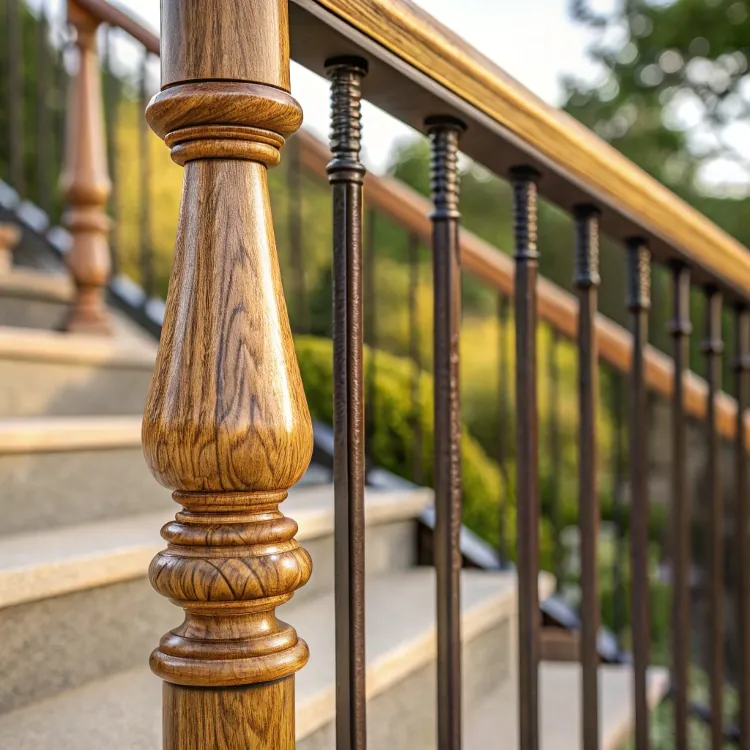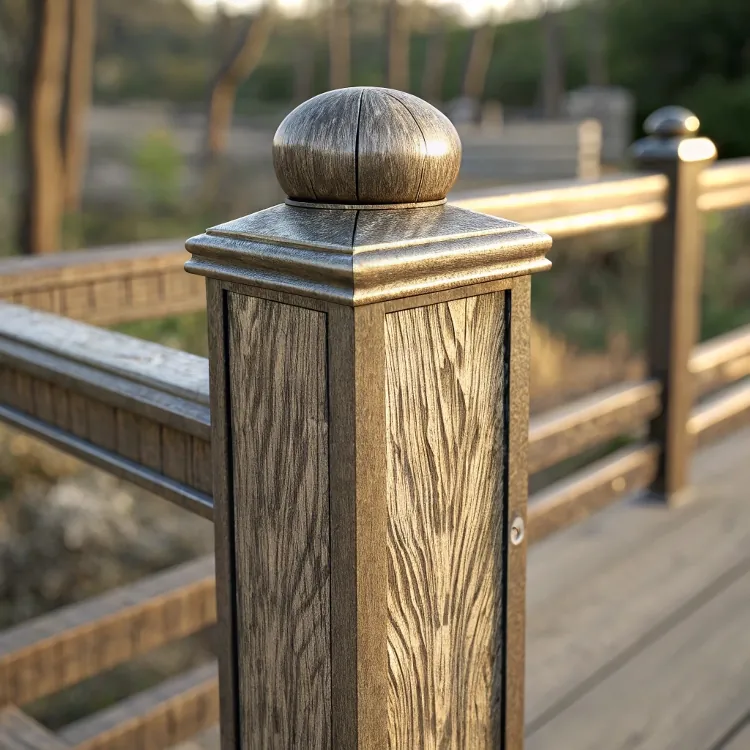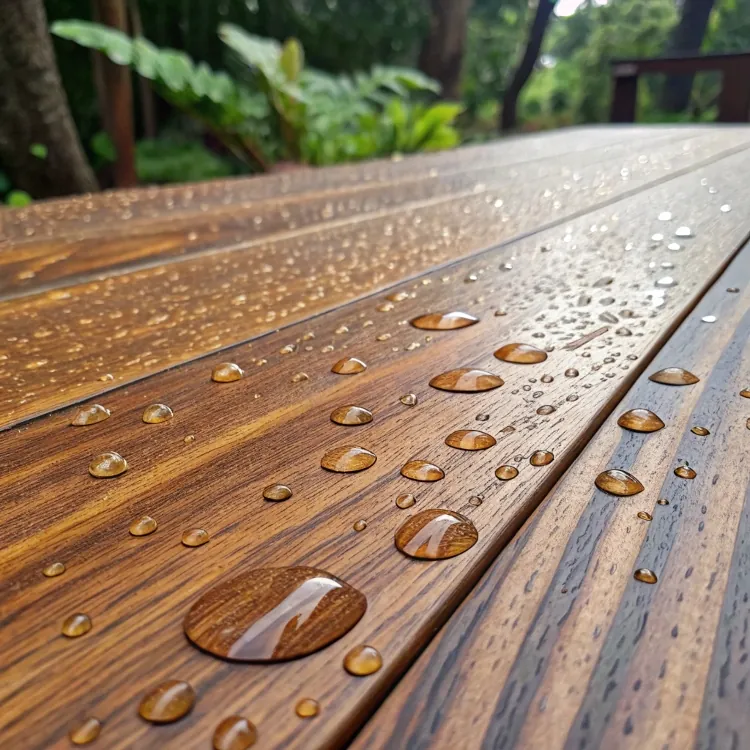Complete Wood Grain Colors On Aluminum: How Do You Achieve Full Wood Grain Color?

Leading paragraph:
Imagine sleek aluminum beams that look like rich oak or walnut wood. It feels surprising, yet appealing.
You can achieve full wood grain on aluminum using advanced coatings like sublimation, powder coating, and wrapping.
Let’s explore how this magic happens, from coating science to real?world durability.
Transition paragraph:
Stay with me—next, I’ll break down each method. You’ll see trade?offs and why certain techniques work better for your use case.
What coating methods create realistic wood grain finishes?

Leading paragraph:
I remember seeing aluminum balusters with perfect maple grain. It stopped me in my tracks.
Realistic wood grain finishes come from techniques like sublimation transfer1, UV-curable paints, powder coating with film, or custom printed wraps.
Which one is right? Let’s dive deeper and compare methods based on color fidelity, texture, cost, and application.
Techniques Compared
1. Sublimation Transfer
With this, you coat the aluminum, apply a heat-activated film printed with wood texture, then bake it. The ink becomes part of the basecoat. It gives vivid grain and offers decent scratch resistance. It’s ideal for architectural trim or panels.
2. Powder Coating with Film Inserts
You apply powder coat, let it tack, embed printed film, then cure. The film fuses under heat. It creates realistic grain and slightly textured feel. It’s durable outdoors and abrasion-resistant.
3. UV-curable Paint with Printing
Some systems print wood grain directly onto cured coating using UV. This method allows tight registration of grain lines and crisp images. The finish is then sealed. This suits low-volume, high-quality custom pieces.
4. Vinyl or Aluminum Wraps
Instead of coating, you wrap parts in printed aluminum or vinyl sheets. The result looks like wood but lacks grain depth and durability. Good for interior trim or temporary finishes.
| Method | Color Realism | Texture Feel | Durability | Cost & Setup |
|---|---|---|---|---|
| Sublimation Transfer | High | Slight texture | Good | Moderate – presses & inks |
| Powder + Film | High | Textured | Very Good | Higher – powder line needed |
| UV?printed coat | Very High | Flat to upholstered | Moderate to High | Low volume, low setup cost |
| Wraps | Moderate | Flat | Low for outdoors | Low upfront cost |
Here are two true/false statements to test your understanding:
Sublimation transfer embeds the grain pattern into the basecoat, making it more durable.True
The ink diffuses into the base coat during heat transfer, resisting wear.
Vinyl wraps are as durable outdoors as powder-coated wood grain.False
Vinyl wraps tend to degrade faster under UV and weather compared to powder-coated finishes.
Can powder coating mimic wood grain textures?

Leading paragraph:
Once I saw fence posts that looked like cedar—only to find they were powder coated. Fascinating.
Powder coating can mimic wood grain by using printed films or texture powders before curing; it’s durable and weather-resistant.
Let’s go deeper into how this works, and what makes it tick.
How Powder Coating Mimics Wood Grain
One method is film insert:
- Print wood pattern on polyester film.
- Pre?treat the aluminum and apply standard powder coat.
- Lay the film onto tacky layer.
- Cure in oven so film fuses into coating.
This gives texture, depth, and durability. It resists scratching, fading, and peeling.
Alternatively, textured powder formulas2 have small particles to give grainy feel. You spray a base color then a darker “grain” powder in areas; this builds up a tactile feel without film.
Pros of Powder-Based Approach:
- Outdoor durability
- UV and abrasion resistance
- No solvent emissions
- Good for long-run jobs
Cons:
- Film wrap adds complexity
- Textured powders give simpler patterns only
Side-by-side table:
| Feature | Film Insert Technique | Textured Powder Only |
|---|---|---|
| Pattern realism | Very high | Moderate |
| Texture | Realistic grain feel | Subtle, rough feel |
| Technical need | Powder line + oven | Standard powder equipment |
| Price per part | Higher | Lower |
| Best for | Architectural panels | Fencing, trim, broad items |
Check your understanding:
Textured powder alone can mimic any complicated wood grain perfectly.False
Powder texture is simpler and less detailed than printed grain.
Film insert powder coating fuses film into coating for durable wood-like texture.True
Heat curing binds the film into the powder, creating a durable finish.
How durable are wood grain aluminum finishes?

Leading paragraph:
I’ve seen wood grain finishes endure rainy seasons and desert sun for years.
Durability depends on method: powder with film and sublimation last decades, UV paint less so, wraps least.
Below I’ll break down life span, maintenance, and failure modes for each.
Durability Analysis
1. Powder Coating with Film
— Expected life is 15+ years outdoors.
— UV resistant, abrasion-proof, handles expand/contract cycles.
— Failures are rare but may include film edge lifting if prep was poor.
2. Sublimation Transfer
— Lasts 10–15 years if sealed well.
— Slight fade over time in harsh sun, but resin excels in resisting weathering.
3. UV-Printed Coats
— Lasts 5–8 years outdoors.
— UV inks may fade, so they need annual seal coating.
— Good indoors or limited external use.
4. Vinyl or Aluminum Wraps
— Outdoor life is 3–5 years max.
— Heat, cold, UV cause peeling, cracking.
— Great for interiors or short?term use.
Durability summary:
| Method | Outdoor Durability | Typical Failures | Recommended Use |
|---|---|---|---|
| Powder + Film | 15+ years | Edge lift, minor fade | High-end architecture |
| Sublimation Transfer3 | 10–15 years | Gradual fade | Mid-to-high exteriors |
| UV paint printed | 5–8 years | Fading, chalking | Aesthetic trim, indoors |
| Vinyl/Aluminum wraps | 3–5 years | Peeling, cracking | Interiors, temporary |
Now two statements:
Powder coating with film insert can last more than 15 years outdoors.True
This method resists UV, abrasion, and weather better than other techniques.
UV?printed wood grain finishes are best for long-term outdoor exposure.False
They tend to fade and chalk faster than powder or sublimation methods.
Conclusion
Realistic wood grain on aluminum is achievable. Powder-film and sublimation give long life outside. UV prints or wraps suit interior use. Choose based on durability needs and budget.
-
Learn more about sublimation transfer and how it can provide vivid wood grain effects for your designs. ↩
-
Learn about textured powder formulas and how they contribute to creating unique finishes, perfect for various applications. ↩
-
Learn about the durability of Sublimation Transfer finishes and how they can withstand various weather conditions, perfect for your exterior needs. ↩



